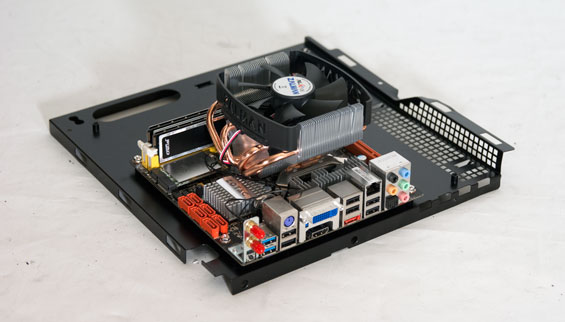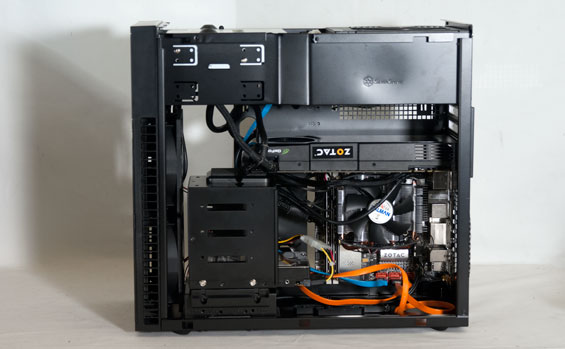SilverStone Precision PS07: Temjin For Less?
by Dustin Sklavos on January 3, 2012 12:20 AM EST- Posted in
- Cases/Cooling/PSUs
- SilverStone
- MicroATX
- Mini-Tower
Assembling the SilverStone Precision PS07
Once again, the SilverStone Precision PS07's assembly was another exercise in deja vu. SilverStone includes an instruction manual that details a very specific way to assemble the enclosure from start to finish to make things as easy as possible, and for the most part it's on the mark. Their cases often feel like puzzles with very specific solutions, and thankfully you don't have to figure them out on your own.

The PS07 comes apart in a few different places. You won't have to remove the front fascia, but the side panels, top panel, motherboard tray, and drive cage all come out. You don't necessarily have to do all of these things, but they can help. SilverStone includes standoffs built into the motherboard tray that makes mounting the board a breeze, but I found locking the tray back into place to be on the awkward side. When I assembled the TJ08-E I opted not to remove the tray to install the board, and that turned out to be the right choice. With the more easily removable drive cage it's simply not necessary.

While ordinarily the power supply is one of the last things I'd install, it pays to pop it into the PS07 early. One of the last things to go in should actually be the optical drive, as you run the risk of dealing with some cable clearance issues in the PS07. Theoretically you can get a 180mm power supply into this enclosure, but honestly you'll want to use a 160mm unit instead like I did for this review build. This is also a situation where using a non-modular power supply may actually be beneficial; there's space behind the motherboard tray to stash excess cables, and modular connections in the PSU can add to the overall length of the unit.

If you're using a tower-style cooler for the CPU heatsink, you'll have to remove the hard drive cage to install 3.5" drives. There's a mount on the bottom of the enclosure for a single 2.5" drive (SSD, naturally), and the ports of the drive line up with the anterior of the motherboard tray nicely, making it reasonably easy to wire. Finally, getting a card like our GeForce GTX 580 in may require some work depending on your motherboard layout, but I found most of the effort involved was the result of our Zotac board packing things in too close to the PCI Express x16 slot.
Given the close quarters of the PS07, the build remains nonetheless surprisingly clean. This isn't the easiest case in the world to assemble, but for its somewhat unusual design there's still a clear logic to how things come together. It's a sharp contrast against some of the Lian Li enclosures I've tested recently, where Lian Li's engineers seem to have their own internal logic they're going to work off of whether the rest of us understand it or not.
















27 Comments
View All Comments
kenyee - Tuesday, January 3, 2012 - link
I was hoping they improved it on this.Once the TJ08 is loaded up, removing a hard drive that died (RAID1) is a PITA...too much stuff to unscrew to get the drive cage out :-P
JaBro999 - Tuesday, January 3, 2012 - link
What was the speed of the TJ08-E's 180 mm Air Penetrator fan running at for the temp and noise comparisons (high or low)?Thanks for the nice review of an interesting case.
Death666Angel - Tuesday, January 3, 2012 - link
The results of the TJ08-E in the comparison charts here are from the fan settings at low. The fan rotates with 700rpm @ low and 1200rpm @ high. Low is normally barely audible, most graphics cards are noisier. High is quite audible and should only be used with headphones.know of fence - Tuesday, January 3, 2012 - link
Now I can appreciate the benefits of an upside down design as much as the next guy, but having the PSU with the open side up is STUPID! That's what happens when people think about airflow and noting else.Imagine a little rain coming through the window a spilled soda, not to mention all the dust and crap that will fall inside.the power supply. Don't let that grill fool you, the PSU needs to go in the right way, with the fan facing the ground, or else there is a risk of shorting out your PC or even electrocution.
Death666Angel - Tuesday, January 3, 2012 - link
If you have your PC next to those things and are clumsy you might want to think about it. However, here my PC is either under the desk to the rear or on the desktop and the window right next to me is never opened. So I can safely rule out death-by-electrocution ;).ClagMaster - Tuesday, January 3, 2012 - link
Changing an optimum case design for lower cost will result in a non-optimum case design.Such is the case of the TJ08-E (perfection) and the PS07(non-optimum).
For the $20 savings, I could have purchased a Rosewill R101-P-BK (on sale) which has excellent acoustics and thermals.
binqq - Friday, January 6, 2012 - link
Our Website: ===== www fashion-long-4biz com ====Our main product list is as follows: